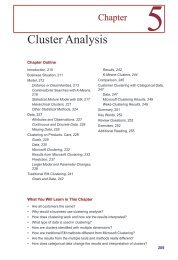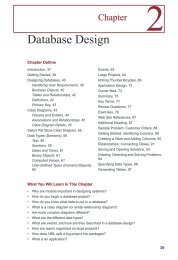Database Projects/5e - Professor Jerry Post
Database Projects/5e - Professor Jerry Post
Database Projects/5e - Professor Jerry Post
You also want an ePaper? Increase the reach of your titles
YUMPU automatically turns print PDFs into web optimized ePapers that Google loves.
Payment History<br />
Customer Gender Date of Birth Taxpayer ID<br />
Number of late payments<br />
Average number of days late<br />
Project Descriptions<br />
Pmt Date Due Paid Date Amount Bank Acct<br />
Figure 4<br />
including the length of the warranty and the level of the deductible. Of course,<br />
longer warranties and lower deductibles cost more. These values are specified in<br />
the warranty policies, but the salesperson needs to enter them on this form so<br />
everyone knows exactly which warranty was purchased. The customer also has<br />
the option of paying the warranty fees upfront as a lump sum, but most decide to<br />
finance them over time in the form of monthly payments. These values are entered<br />
by the salesperson using a chart—essentially the company charges a one percent<br />
per month interest rate for financing the warranty costs.<br />
To provide documentation for situations when complaints arise, or when RMN<br />
has to repossess a car, the company records all of the payments made by the customer.<br />
Figure 4 shows the basic form. To provide faster lookups (on the paper<br />
forms), the clerk also updates the number of late payments and the average number<br />
of days late whenever a payment is late. The company uses date of birth, gender,<br />
and taxpayer number to obtain credit reports on the customer. Really bad customers<br />
are also reported to the credit bureaus.<br />
On average, the company sells 5-10 cars a week, and generally tries to keep no<br />
more than 50 cars on the lot at one time. However, if good deals pop up at auctions,<br />
the buyers are encouraged to purchase them, but then they hold off on buying<br />
the marginal cars.<br />
Exercises<br />
1. Create the feasibility study (initial proposal).<br />
2. Create a list of all of the forms and reports that the company might use.<br />
3. Create a normalized list of tables for each form and report.<br />
4. Create an integrated list of normalized tables for the entire application. Draw<br />
the corresponding class diagram.<br />
5. Create the basic tables in a DBMS along with all necessary relationships and<br />
integrity constraints. Enter sample data into the tables to test your design.<br />
6. Evaluate the normalized tables and estimate the size of the database—both<br />
current size and estimated size in 3 years.<br />
7. List the initial security conditions for the data tables. Create a list of user<br />
groups and identify their basic access needs.<br />
5







